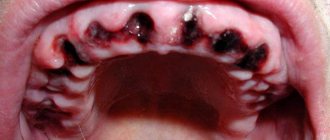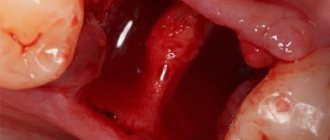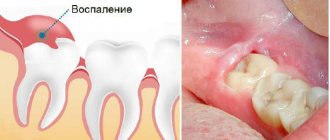Situations in which swelling is not a cause for concern
In many cases, swelling that occurs after tooth extraction is normal and should not cause alarm.
There is no need to worry if:
- The swelling is mild and does not increase over time. If tooth extraction turned out to be traumatic or was carried out against the background of severe inflammation, then slight swelling is allowed to appear, which should go away on its own in a couple of days.
- Body temperature is slightly elevated, but does not increase over time, or is completely within acceptable values. Removing a tooth when it is inflamed can cause a slight increase in temperature, which, if the source of pain has been eliminated, quickly subsides.
- There is no increasing pain. A sign of normality is the presence of slight pain (after all, removal is a surgical procedure during which soft tissues are injured), gradually decreasing over time. If the pain does not go away, or its strength increases, then this indicates either increasing inflammation or the occurrence of any complications.
- The hole left after the operation is closed with a blood clot. Naturally, after the procedure, the hole is filled with rapidly clotting blood. This clot reliably protects the tissue, preventing the development of an inflammatory process.
After removal, the cheek may look swollen for one day - this is a period during which you should not worry. If after 24 hours there is no obvious deterioration and the swelling decreases, there is no need to waste time on a visit to the dentist. But if at least one of the symptoms listed above is present, this indicates the need to make an appointment with a dentist as quickly as possible in order to prevent the situation from worsening.
What can lead to severe swelling
Some diseases and complications lead to similar non-standard reactions of the body to tooth extraction. Let's look at them in more detail:
- Systemic chronic diseases. These include diabetes, hypertension, cardiovascular diseases, and low immunity. All these diseases impair the body’s ability to recover after surgical procedures.
- Alveolitis is an inflammation of the alveolus (socket) that remains after tooth extraction. The cause of inflammation can be general diseases, smoking, mechanical damage, or non-compliance with doctor’s recommendations. As a result, a blood clot does not form in the socket, severe pain, a gray coating and an unpleasant odor occur. If alveolitis is not cured in time, dangerous purulent diseases such as phlegmon and osteomyelitis may develop.
- Difficult tooth extraction. The presence of dental anomalies associated with incorrect tooth position (dystopia, retention) almost always complicates the extraction process. Often these deviations lead to greater trauma and, as a result, more pronounced swelling. The same can be said for third molar extractions. If the operation was performed professionally and the patient followed the dentist’s instructions, then there is no reason to worry.
- Incorrect tooth extraction. Doctor's mistakes include: incomplete root removal, removal of the interradicular septum, leaving fragments in the alveolus, infection. A more rare cause of inflammation is the presence of a cyst that was not detected during surgery: its growth is accompanied by an increase in edema.
To speed up healing and eliminate any unpleasant symptoms that may arise, do not delay your visit to the dentist. It is advisable to contact the surgeon who performed the tooth extraction procedure.
When you can't do without a doctor's help
If any of the situations listed below arise, you need to go to the dentist, who will take the necessary measures (wash the hole, put in medicine, take measures to release pus, etc.).
So, you can’t do without a trip to the dental clinic if:
- The swelling that appears after removal does not subside, but, on the contrary, grows. In this case, there is no point in continuing to wait, since it is obvious that the situation will not resolve itself. Swelling may indicate inflammation or suppuration. In some cases, swelling can develop to large sizes, affecting the area under the eye.
- There is pain that does not decrease over time. Severe pain for a couple of days is acceptable only with a particularly difficult removal, accompanied by sawing out the bone: in all other situations, the pain should decrease and completely disappear after 1-2 days.
- The temperature rises.
- Feeling unwell does not go away.
- There are difficulties opening the mouth and making swallowing movements.
- There is no blood clot in the hole left after tooth extraction. Perhaps the clot simply fell out or was washed out when rinsing the mouth. If there is no clot, then the risk of inflammation increases, which is accompanied by very severe pain. It is useless to wait patiently for the pain to go away on its own: the dentist, having assessed the situation, will administer the required medicine, which will quickly relieve the discomfort.
Sometimes swelling does not appear immediately, but 3-4 days after surgery. Typically this is due to the fact that:
- the blood clot in the socket has festered;
- inflammation began in the hole.
This condition is called alveolitis. With this inflammatory lesion, self-medication using antibiotics and other medications is pointless. Only a doctor can alleviate the patient’s condition by clearing the hole of small food debris and placing medicine inside.
Sometimes a hematoma may form on the gum. In the first few days after its appearance, it may not cause attacks of pain or lead to swelling of the cheek, however, when obvious signs of suppuration are visible, leading to pain, you should consult a dentist, who will most likely open the hematoma.
Possible consequences
Even simple tooth extraction is accompanied by tissue injury. During the operation, blood vessels and mucous membranes are damaged, so for 3-7 days the patient may be bothered by:
- swelling,
- pain of different localization,
- discomfort in the oral cavity,
- slight increase in body temperature,
- discomfort when closing the jaws.
After tooth extraction, a wound remains in the gum, which takes at least one week to heal. It is necessary to ensure that the hole is always filled with blood. The blood clot prevents food particles and pathogenic bacteria from entering the socket.
When should swelling occur?
There are situations when the development of noticeable edema is inevitable. They arise:
- After an operation of increased complexity. Removal accompanied by damage to nearby tissues (for example, when it is necessary to saw out bone or incisions in the mucous membrane) leads to the appearance of edema. In some situations (for example, when the eighth tooth is removed), facial asymmetry is likely to occur.
- When removed due to severe inflammation. Then an infection remains in the hole, which can become the main cause of swelling. If the operation is carried out in compliance with all the rules, then the dentist, seeing inflammation, is obliged to thoroughly rinse the wound with an antiseptic solution, and then apply the medicine. Sometimes antibiotics are prescribed. However, even then it cannot be said that the inflammatory process will not begin.
- When cutting the gums on which there is an abscess, the dentist makes an incision to release the pus located in the soft tissues. If there was already a slight swelling during the procedure, it may increase slightly in size, which is normal.
- When contacting people suffering from certain diseases. Quite often, according to the observations of dentists, patients who have high blood pressure complain about swelling of the cheek after tooth extraction, leading to the accumulation of a subcutaneous fat layer on the face. In such people, swelling may well appear even with normal removal, which proceeds without any complications.
Severe pain after removal and surgeon error -
When a tooth has been removed, the gums hurt so much that even strong analgesics help little - the reason most often turns out to be the incompetence of the surgeon. Unfortunately, many surgeons do not strive to minimize trauma to bone tissue and gums during the removal process, which leads to severe pain. Below we list the main medical “flaws” in the process of tooth extraction -
- When cutting out bone with a drill - according to the rules, when cutting out bone around a tooth, the doctor must use a surgical handpiece that supplies coolant to the drilling area.
In 90% of cases, handpieces without such cooling are used in surgical rooms (24stoma.ru). As a result, the bone suffers a thermal burn and superficial necrosis, and the patient suffers acute pain after removal. If you have had a bone cut out and your gums hurt after tooth extraction: what to do in such a situation will depend on the condition of the socket of the extracted tooth. If the clot is dense and there are no symptoms of inflammation other than pain, you should wait and take strong NSAID-based analgesics. If the socket is empty and there are signs of inflammation (see below), you need to go for a second visit to the dentist and clean the socket.
- Sharp edges of the bone stick out from the socket (Fig. 4-5) - if the bone walls have sharp edges after tooth extraction, then they can injure and break through the mucous membrane (Fig. 4), and even stick out from under it. Or if the interradicular bone septum of multi-rooted teeth has a large height, then it may not be completely covered by a blood clot, protruding from under it.
The origin of this problem is that the doctor either did not bite down the sharp edges of the bone and the high interradicular septum with forceps, or did not apply sutures to the too mobile gum around the tooth in order to bring the edges of the wound closer together. The presence of exposed bone fragments can be determined by the characteristic pain when touching such fragments with the tongue, as well as the occurrence of acute pain in response to cold/hot water. Sometimes they can be seen with the naked eye in the mirror.
- Moving bone fragments in the wound - the surgeon can leave large, inactive bone fragments in the socket of the extracted tooth, which are formed when the tooth dislocates/rocks. Their presence can lead to severe pain and inflammation of the extracted tooth socket, as well as the need for a second visit to the surgeon to remove them.
- An incorrect removal strategy is the most common mistake. The fact is that different doctors (due to differences in experience and intelligence) remove exactly the same teeth in different ways. This leads to the fact that one surgeon can torment the patient for 1-2 hours, trying to use only forceps and elevators when removing and regardless of the trauma caused to the bone, while another will decide to immediately saw the tooth into 2 parts (removing them separately), and spending only 15-25 minutes on the entire removal.
- “Empty hole” (Fig. 6) –
if the doctor used too much anesthetic with a vasoconstrictor (this component promotes vasospasm at the site of anesthesia), then the hole after removal may not fill with blood. Doctors usually don't test for this, but simply apply a tampon and send the patient home. In an empty socket, the bone tissue will be exposed and will react with severe pain.
- The doctor did not put sutures - before removal, the mucous membrane around the tooth is peeled off from it with a trowel, which leads to the fact that the edges of the mucous membrane around the socket of the extracted tooth will be mobile.
Often, even seeing the need for suturing, surgeons are too lazy to do it. Ideally, at least 1 suture should be applied even after the removal of small single-rooted teeth, not to mention multi-rooted ones. Studies have shown that suturing the socket can reduce the intensity of pain by 30-50%, reduce the risk of developing inflammatory complications by up to 90%, accelerate wound healing, and almost completely prevent the loss of a blood clot from the socket and the risk of bleeding. I can recommend to you - always, before removal, ask the doctor to suture the hole (even if you have to pay an extra 250-500 rubles for 1 or 2 stitches). This will save you a lot of nerves. - If the doctor does not prescribe antibiotics after a complex removal, there is a high risk of developing inflammation of the socket and, as a result, severe pain. Antibiotics should only be prescribed by a doctor, so you should go for a re-examination and complain about pain.
What to do in all these situations -
How long does the gum hurt after tooth extraction in these situations - normally, pain should last no more than 1-2 days after simple removal, and its severity should be mild or moderate. Moreover, pain, swelling (if it also appears) and other negative symptoms should gradually decrease. After complex removal, pain can be severe and normally last 3-5 days, but starting from the next day they will also begin to decrease.
If the intensity of the pain does not decrease within 2 days, if you feel bone fragments in the wound with your tongue, if you experience pain in the socket when responding to cold/hot water, if a blood clot has fallen out of the socket, if there is an unpleasant odor from the socket... – you need to urgently go to the surgeon for a second appointment (without waiting for your gums to become inflamed after tooth extraction).
Important: in some cases, pain can also be caused by the patient’s mistakes in how he cares for the socket of the extracted tooth. For example, very often patients begin to rinse their mouth intensively, believing that this will be better. But this leads to the blood clot falling out of the socket and causing severe pain. Read about what you can and cannot do after removal in our article: → “Memo for the patient on how to behave after removal”
How to get rid of swelling at home
If there is no reason to see a doctor, but you want to get rid of the swelling as soon as possible, you can try the following methods:
- Immediately after removal or surgery, apply a cold compress (water bottle, wet cloth). The application must be repeated throughout the day once every half hour for 5 minutes. ATTENTION! Using a cold compress on the second, third, etc. day is unacceptable.
- Use special decongestant ointments.
- Sleep with your pillow raised high.
- After a few days, cold compresses are replaced with warm ones. A single session of the procedure should not exceed half an hour. Vasodilation and increased blood flow promote faster recovery.
- use corticosteroids. Since this type of drug has many side effects, it is better to consult a doctor before taking it. You should resort to these medications only in cases of extreme necessity, when pain due to swelling interferes with normal daily activities.
- These methods should be used if there are no complications: in other cases, it is recommended to consult a doctor for a detailed examination.
What to do to eliminate the tumor?
If, after the removal of a wisdom tooth, the tissues nearby are swollen, then the patient’s main task is to follow all the doctor’s instructions after the procedure. This is the only way to minimize swelling and pain.
It is necessary to keep the affected area cold and under no circumstances heat it - this is the main and fundamental condition for the fight against swelling. The cold is kept every hour and a half for 7-10 minutes during the first day after the intervention. A thick cloth soaked in cool water or a bottle of water chilled in the freezer are suitable as a source of cold. In this case, you need to periodically change the compress when it warms up, and make sure that the skin is not frostbitten.
It is advisable to measure the temperature on the first day after surgery; it may increase, but should not exceed 38°C.
Eating hot food and drinking, taking a hot bath or shower, and visiting bathhouses is prohibited for at least two to three days after the event. Also, after removing a wisdom tooth, you should not puff out your cheeks and rinse out the protective blood clot from the wound. It is not recommended to chew on the removal side.
Antibiotics are prescribed as medications (for example, Tsiprolet 500 mg for 5 days, two tablets per day) to reduce the risk of infection. Painkillers are also prescribed (in particular Nimesil powders, no more than three packets per day).
Be sure to brush your teeth, this again reduces the risk of infection. However, you should be careful near the socket of the extracted tooth so as not to damage the protective blood clot. For the procedure, it is better to give preference to a tool with soft bristles.
Whether the cheek is swollen after the removal of a wisdom tooth or not, for the treatment and prevention of swelling, in any case, you can use Dicynone, treat the wound with Miramistin, or do oral baths with chlorhexidine. You can also rinse your mouth with anti-inflammatory substances and solutions: infusion of chamomile or sage, furacillin, etc. But rinsing should be done very carefully so as not to disturb the protective clot.
Special gels will help reduce tissue swelling and pain, and also effectively fight inflammatory processes. The prescription of such medications is carried out only by the attending dentist.
It is also advisable to at least temporarily exclude cigarettes, alcoholic beverages, foods with a lot of salt, sugar, hot spices and solid foods from your life. During the healing period after surgery, it is better to give preference to foods with a soft consistency.
Complications of edema and methods of dealing with them
Often, swelling is accompanied by one or more complications from the list below:
- bleeding. A little bleeding is normal. If there is more blood, the wound can be pressed with a gauze pad moistened with an antiseptic (for example, Chlorhexidine). If bleeding does not go away for more than 2 days, you should not delay visiting a doctor;
- numbness. After any dental procedure, the area around the mouth may lose sensation. There is nothing wrong with this if the side effect goes away within 12 hours;
- the occurrence of pain, which is acceptable even after surgery. The main rule is that pain should decrease within a couple of days. In some cases, the pain can be so severe that a person cannot chew food (the condition should last no more than 5 days). To alleviate this condition, you can take painkillers (for example, paracetamol);
- the occurrence of a dry socket after surgery (especially important for smokers). In this case, a blood clot, without which the healing process is impossible, does not form. The condition is often accompanied by a feeling of pain and an unpleasant taste in the mouth. The most effective way to combat it is to wash the wound several times a day, followed by applying an antiseptic bandage.
Diseases that occur after tooth extraction and cause swelling
When teeth are removed (in particular, molars, canines and incisors), the following diseases may occur:
- alveolitis, when suppuration of the hole occurs. Accompanied by swelling of the cheeks and cheekbones. The temperature rises, general weakness occurs, and bad breath appears;
- osteomyelitis is a disease in which the jaw bone becomes inflamed (the process is accompanied by the formation of pus). The cheek swells at the site of inflammation, and the pain affects the entire row of teeth. It becomes painful for a person to open his mouth and talk. The disease is accompanied by severe headache and fever; in some cases, blood poisoning is possible (if you do not consult a doctor in time);
- neuritis. The facial nerve is affected, which is accompanied by acute pain. Quite often it occurs when teeth with long roots are removed. With neuritis, the cheek becomes swollen and numb; numbness also affects the palate, larynx and tongue.
When to see a doctor?
If the swelling increases over the course of a week and does not subside, you should make an appointment with your dentist. You should also consult a doctor if the following symptoms appear:
- temperature rise to 38-39 degrees,
- putrid odor from the mouth,
- increasing pain,
- difficulty opening the mouth,
- swelling of the eyes, neck and other places.
These signs indicate the development of serious complications. This could be gumboil, alveolitis, or dental cyst. A dentist will help determine the exact cause. Do not delay your visit to a specialist and do not wait for the swelling to subside.
How to prevent complications?
To avoid swelling and subsequent treatment, it is recommended:
- Keep your head held high for at least 12 hours after surgery (or better yet, 24 hours). To do this, while lying down, you need to place several pillows under your head;
- do not touch the hole with your tongue or fingers;
- do not use warm compresses for 36 hours after surgery;
- do not smoke or drink alcohol for 72 hours after surgery.
Correct behavior after surgery is no less important than the procedure itself: if you adhere to the above rules, the swelling will go away either in the shortest possible time or will not occur at all.
Preventive measures
Since the likelihood of swelling after tooth extraction is quite high, the following recommendations should be followed to minimize the risk of cheek swelling (the same rules apply in cases where swelling has already formed and needs to be removed as soon as possible):
- use oral baths (the salt liquid is only kept in the mouth without rinsing, since otherwise infection of the hole may occur);
- use anesthetics to relieve pain. As a rule, these are Ketanov, Ibuprofen and other similar drugs that reduce the inflammatory process and relieve pain. The most important thing is to follow the dosage indicated in the instructions;
- follow the diet. If an operation has been performed, then on the first day you should not eat hard or hot food, as it can cause injury to the already damaged gum. During the week after surgery, the basis of the diet should be soft and non-spicy foods. Until the swelling goes away, it is better to chew on the other side of the mouth, doing it slowly;
- Avoid taking hot baths, as this may cause bleeding from the socket;
- When brushing your teeth, skip the operated area until the swelling goes away.
- On average, swelling subsides within 2-3 days from the date of surgery: if this does not happen, you will have to contact the dentist again for an examination and additional research if necessary.











